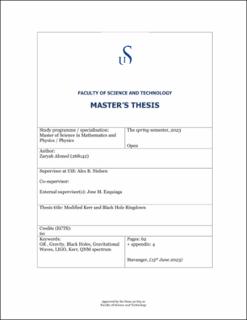| dc.description.abstract | In the post-merger phase of a black hole binary system, the remnant object is a perturbed black hole emitting gravitational radiation in the form of Gravitational Waves (quasi-normal modes) before admitting a stable state. Observations of gravitational waves can thus be used to test and constrain deviations from Einstein’s theory of gravity. The no-hair theorem says that only 2 parameters are required to characterize an astrophysical black hole described by the Kerr metric; mass and spin. However, in the post-Kerr approximation, the metric incorporates non-Kerr parameters. We assume that the observed rigndown can be described by the Johanssen-Psaltis metric and use LIGO data to constrain the deviation parameter. Compared to existing constraint, our analysis finds a tighter constraint on the deviation parameter ε_3 using GW190521 ringdown data. | |
